Genetic Algorithms Genetic Algorithms l components of a






















































































































![Stochastic Universal Sampling begin set current_member=i=1; pick uniform r. v. r from [0, 1/m]; Stochastic Universal Sampling begin set current_member=i=1; pick uniform r. v. r from [0, 1/m];](https://slidetodoc.com/presentation_image_h/783f3cb909014b3b82a254ef4b88d28a/image-119.jpg)

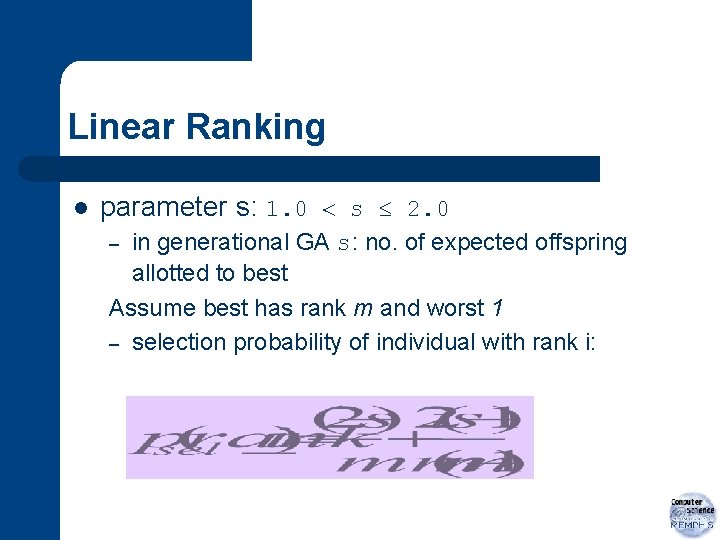
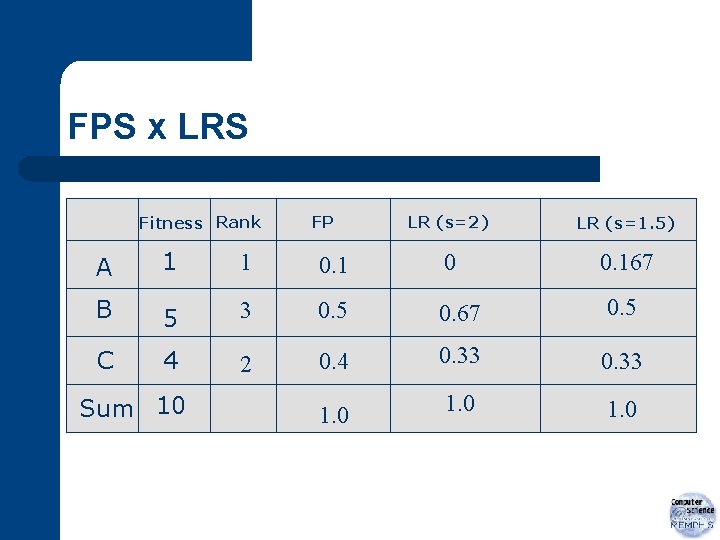
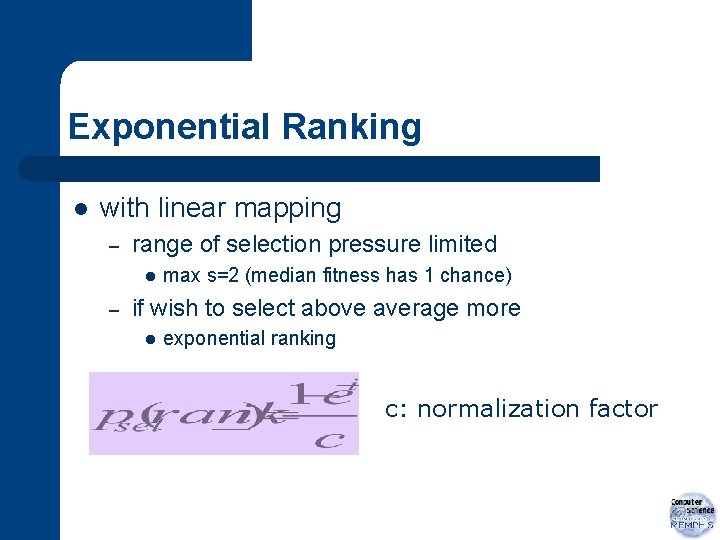
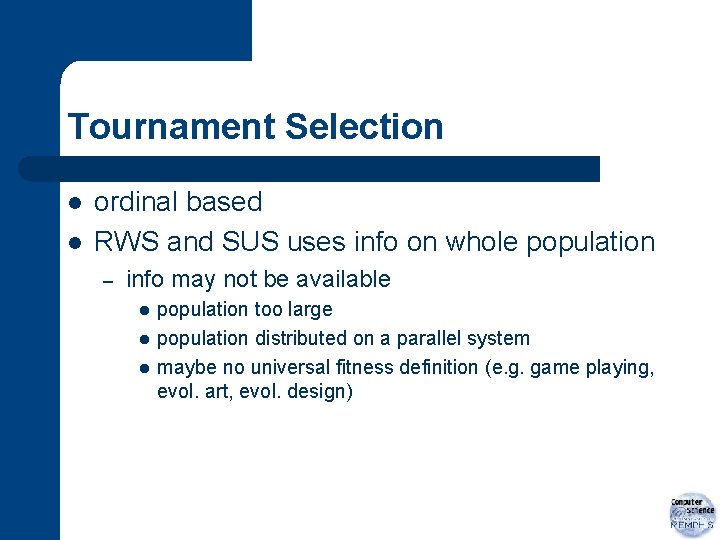
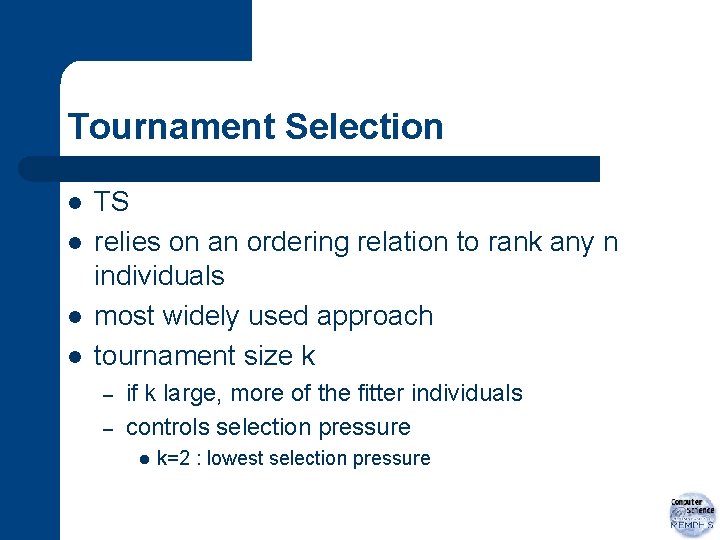
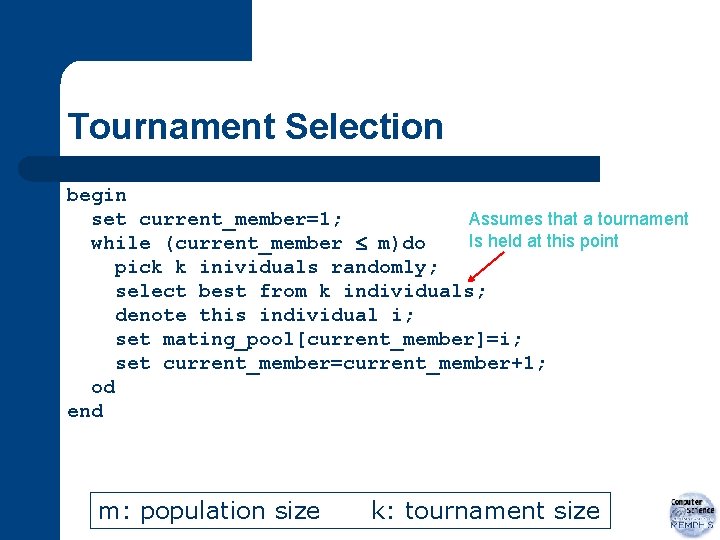
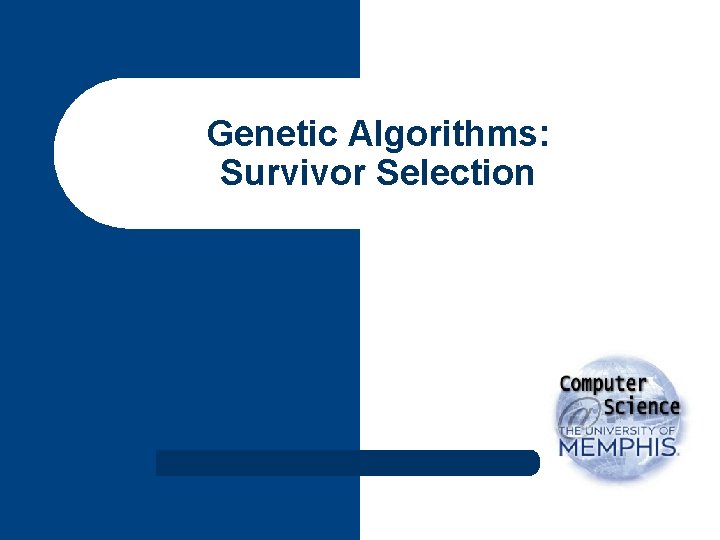
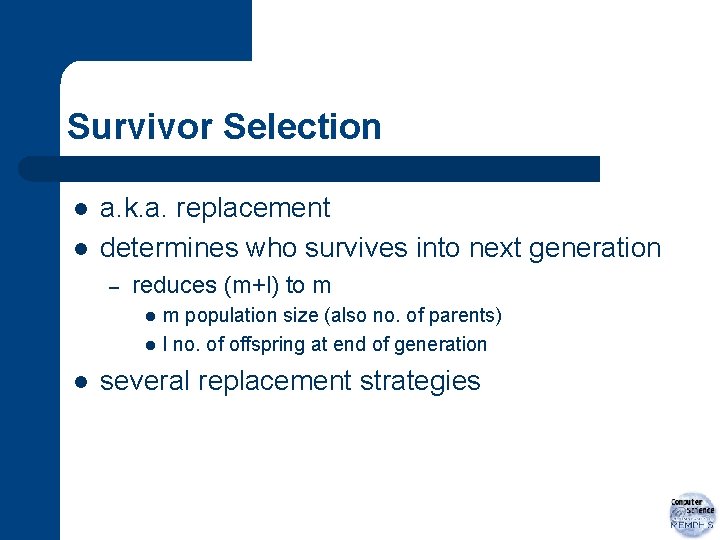
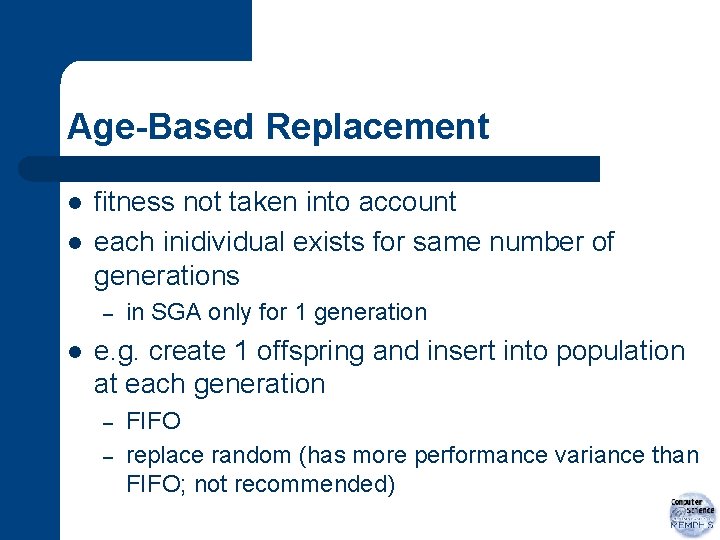
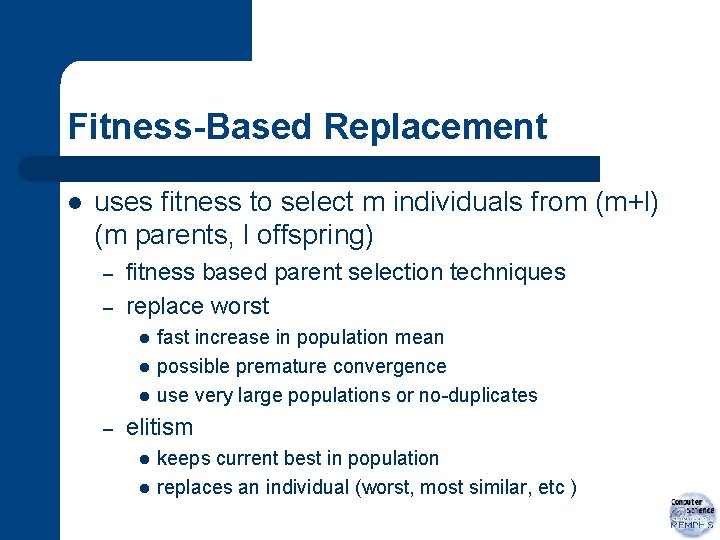
- Slides: 130

Genetic Algorithms

Genetic Algorithms l components of a GA – – – representation for potential solutions method for creating initial population evaluation function to rate potential solutions genetic operators to alter composition of offspring various parameters to control a run

Genetic Algorithms l parameters of a GA – no. of generations l – – – or other stopping criteria population size chromosome length probability of applying some operators

Simple GA

Simple GA - SGA l l a. k. a. Canonical GA Operators of a SGA – – – selection cross-over mutation

SGA generate initial population repeat evaluate individuals perform reproduction select pairs recombine pairs apply mutation until end_of_generations

Representation & Encoding l l l population size constant individual has one chromosome (haploid) chromosome length constant individual has a fitness value binary genes (0/1) generational

Initial Population random initial population each gene value for each individual determined randomly to be either 0 or 1 with equal probability

Fitness Evaluation l fitness function – – l shows fitness of individual – l objective function(s) constraints degree to which solution candidate meets objective apply fitness function to individual

Example Problem: One-Max Objective: maximize the number of 1 s in a string of length 5, composed only of 1 s and 0 s population size = 4 chromosome length = 5 fitness function = no. of genes that are 1

Example Population individual 1: chromosome = 11001 fitness = 3 individual 2: chromosome = 00001 fitness = 1 individual 3: chromosome = 11111 fitness = 5 individual 4: chromosome = 01110 fitness = 3

Reproduction l consists of – selection l l – – mating pool (size same as population) possibly more than one copy of some individuals cross-over mutation

Selection l uses roulette wheel selection – fitness proportionate l expected no. of representatives of each individual is proportional to its fitness

Example Selection Current Population: i 1: 11001, 3 i 2: 00001, 1 i 3: 11111, 5 i 4: 01110, 3 Probability of each individual being selected: prob(i 1) = 3/12 = 0. 25 prob(i 2) = 1/12 = 0. 08 prob(i 3) = 5/12 = 0. 42 prob(i 4) = 3/12 = 0. 25 Expected copies of each individual in pool: i 1: i 2: i 3: i 4: (3/12*4) (1/12*4) (5/12*4) (3/12*4) 1 0 2 1 Assume: wheel is turned 4 times 1 copy of i 1 2 copies of i 3 1 copy of i 4 is copied into mating pool

Example Pairing Current mating pool: mate Pairs: Pair 1: 11001 11111 1: 2: 3: 4: 11001 (i 1) 11111 (i 3) 01110 (i 4) Pair 2: 11111 01110 Assume: As a result of random drawing (mate 1, mate 3) and (mate 2, mate 4) are paired off for reproduction.

Recombination l l l new individuals formed from pairs of parents one point cross-over probability of cross-over: pc – – a. k. a. cross-over rate typically in range [0. 5, 1. 0]

One-Point Cross-Over

Example Cross-Over Assume pc=1. 0 for pair 1: cross-over site: 3 110 | 01 11011 111 | 11 11101 for pair 2: cross-over site: 1 1 | 11110 0 | 1110 01111 the new individuals: i 1: 11011 i 2: 11101 i 3: 11110 i 4: 01111

Mutation l l bitwise mutation probability of mutation: pm – – a. k. a. mutation rate equal probability for each gene chromosome of length L; expected no. of changes: L*pm typically chosen to be small l depends on nature of problem

Bitwise Mutation

Example Mutation Assume: as a result of random draws, 1 st gene of i 1 and 4 th gene of i 3 are found to undergo mutation i 1: 11011 01011 i 3: 11110 11100

Population Dynamics l generational GA – – non-overlapping populations offspring replace parents

Example New Population individual 1: chromosome =01011 fitness = 3 individual 2: chromosome =11101 fitness = 4 individual 3: chromosome =11100 fitness = 3 individual 4: chromosome =01111 fitness = 4

Stopping Criteria l main loop repeated until stopping criteria met – – – for a predetermined no. of generations until a goal is reached until population converges

Convergence l l l progression towards uniformity gene convergence: when 95% of the individuals have the same value for that gene population convergence: when all genes have converged – average fitness approaches best

Example Stopping Criteria Case 1: number of generations= 250 – – – loop repeated 250 times best individual at each generation found overall best individual becomes solution

Example Stopping Criteria Case 2: objective: maximize the number of 1 s goal: to find the individual with 1 for all gene locations – – – loop repeated forever best individual at each generation found terminates when goal individual found

Example Stopping Criteria Case 3: 95% of 4 is 4 gene convergence: 4 individuals must have same value for a gene location population convergence: 5 gene locations must be converged Example converged populations: Example 1: Example 2: Example 3: i 1: 11010 i 1: 00000 i 1: 11111 i 2: 11010 i 2: 00000 i 2: 11111 i 3: 11010 i 3: 00000 i 3: 11111 i 4: 11010 i 4: 00000 i 4: 11111

Example Problems

Function Optimization Objective: Find the set of integers xi which maximize the function f. f(xi)= ixi 2 i=1, 2, 3 -512 < xi 512

Function Optimization Representation: – – 1024 integers in given interval 10 bits needed 0 1 2 : 00000 (-511) : 000001 (-510) : 000010 (-509). . . 1023 : 11111 (512)

Function Optimization Individual: l function has 3 parameters: x 1, x 2, x 3 (-512 < xi 512) l 10 bits for each xi l chromosome has 30 bits

Function Optimization Example chromosome: 1100101100000000110 x 1 x 2 x 3 x 1 = (810 - 511) = 299 x 2 = (768 - 511) = 257 x 3 = (6 - 511) = -505 fitness = (299)2 + (257)2 + (-505)2 = 410475

Function Optimization what if xi were real numbers? l interval: -5. 12 < xi 5. 12 possible to use binary l precision of 2 digits after decimal – use 1024 different integers (divide number by 100) use other representations (e. g. real) –

Function Optimization what if representation has redundancy? e. g. interval: -5. 4 < xi < 5. 4

0/1 Knapsack Problem Objective: xi = 0 / 1 (shows whether item i is in sack or not)

0/1 Knapsack Problem Example item set: (1) w= 2, v=10 (2) w= 6, v= 3 (3) w=10, v= 8 (4) w= 7, v=16 (5) w= 4, v=25 Example knapsack capacity: W = 12 Example feasible solutions: items: {1, 2, 5} weight=12 value= 38 items: {3} weight=10 value= 8 items: {4, 5} weight=11 value= 41 items: {2} weight=6 value= 3

0/1 Knapsack Problem Representation: 5 items chromosome length 5 Example chromosomes: 11001 items {1, 2, 5} included in sack 00100 items {3} included in sack 00011 items {4, 5} included in sack 01000 items {2} included in sack

0/1 Knapsack Problem l Can fitness be total weight of subset? – l what if overweight? how to handle overweight subsets? – – delete? penalize? l – by how much? make correction?

Exercise Problem In the Boolean satisfiability problem (SAT), the task is to make a compound statement of Boolean variables evaluate to TRUE. For example consider the following problem of 16 variables given in conjunctive normal form: Here the task is to find the truth assignment for each variable xi for all i=1, 2, …, 16 such that F=TRUE. Design a GA to solve this problem.

Genetic Algorithms: Representation of Individuals

Binary Representations l l simplest and most common chromosome: string of bits – genes: 0 / 1 example: binary representation of an integer 3: 00011 15: 01111 16: 10000

Binary Representations problem: Hamming distance between consecutive integers may be > 1 example: 5 bit binary representation 14: 01110 15: 01111 16: 10000 Probability of changing 15 into 16 by independent bit flips (mutation) is not same as changing it into 14! (hamming cliffs) Gray coding solves problem.

Gray Coding Hamming distance 1 Example: 3 -bit Gray Code l integer standard gray l 0 1 2 3 4 5 6 7 000 001 010 011 100 101 110 111 000 001 010 111 100 algorithms exist for – – gray binary coding binary gray coding

Integer Representations l binary representations may not always be best choice – l another representation may be more natural for a specific problem e. g. for optimization of a function with integer variables

Integer Representations l values may be – – unrestricted (all integers) restricted to a finite set l l e. g. {0, 1, 2, 3} e. g. {North, East, South, West}

Integer Representations l any natural relations between possible values? – – obvious for ordinal attributes (e. g. integers) maybe no natural ordering for cardinal attributes (e. g. set of compass points)

Real-Valued / Floating Point Representations l l when genes take values from a continuous distribution vector of real values – l floating point numbers genotype for solution becomes the vector <x 1, x 2, …, xk> with xi

Permutation Representations l deciding on sequence of events – l in ordinary GA numbers may occur more than once on chromosome – l most natural representation is permutation of a set of integers invalid permutations! new variation operators needed

Permutation Representations l two classes of problems – based on order of events l e. g. scheduling of jobs – – Job-Shop Scheduling Problem based on adjacencies l e. g. Travelling Salesperson Problem (TSP) – finding a complete tour of minimal length between n cities, visiting each city only once

Permutation Representations l two ways to encode a permutation – – ith element represents event that happens in that location in a sequence value of ith element denotes position in sequence in which ith event occurs

Permutation Representations Example (TSP): 4 cities A, B, C, D and permutation [3, 1, 2, 4] denotes the tours: first encoding type: [C A B D] second encoding type: [B C A D]

Genetic Algorithms: Mutation

Mutation l l a variation operator create one offspring from one parent acts on genotype occurs at a mutation rate: pm – behaviour of a GA depends on pm

Bitwise Mutation l l flips bits – 0 1 and 1 0 setting of pm depends on nature of problem – usually (expected occurence) between 1 gene per generation and 1 gene per offspring

Bitwise Mutation (Binary Representations)

Integer Representations: Random Resetting l l l bit flipping extended acts on genotype mutation rate: pm a permissible random value chosen most suitable for cardinal attributes

Integer Representations: Creep Mutation l l l designed for ordinal attributes acts on genotype mutation rate: pm

Integer Representations: Creep Mutation l add small (positive / negative) integer to gene value – – random value sampled from a distribution l l symmetric around 0 with higher probability of small changes

Integer Representations: Creep Mutation l step size is important – – l controlled by parameters setting of parameters important different mutation operators may be used together – – e. g. “big creep” with “little creep” e. g. “little creep” with “random resetting” (different rates)

Floating-Point Representations: Mutation l l l allele values come from a continuous distribution previously discussed mutation forms not applicable special mutation operators required

Floating-Point Representations: Mutation Operators l change allele values randomly within its domain – upper and lower boundaries l Ui and Li respectively

Floating-Point Representations: Uniform Mutation l values of xi drawn uniformly randomly from the [Li, Ui] – analogous to l l l bit flipping for binary representations random resetting for integer representations usually used with positionwise mutation probability

Floating-Point Representations: Non-Uniform Mutation with a Fixed Distribution l l most common form analogous to creep mutation for integer representations add an amount to gene value amount randomly drawn from a distribution

Floating-Point Representations: Non-Uniform Mutation l Gaussian distribution (normal distribution) – – – with mean 0 user-specified standard deviation may have to adjust to interval [Li, Ui]

Floating-Point Representations: Non-Uniform Mutation l Gaussian distribution – 2/3 of samples lie within one standard deviation of mean l l most changes small but probability of very large changes >0 Cauchy distribution with same standard deviation – probability of higher values more than in gaussian distribution

Floating-Point Representations: Non-Uniform Mutation l usually – – applied to each gene with probability 1 pm used to determine standard deviation of distribution l determines probability distribution of size of steps taken

Permutation Representations: Mutation Operators l l l not possible to consider genes independently move alleles around in genome mutation probability shows probability of a string undergoing mutation

Permutation Representations: Swap Mutation

Permutation Representations: Insert Mutation

Permutation Representations: Scramble Mutation • May act on whole string or a subset

Permutation Representations: Inversion Mutation

Genetic Algorithms: Recombination

Recombination l process for creating new individual – l term used interchangably with crossover – l two or more parents mostly refers to 2 parents crossover rate pc – – typically in range [0. 5, 1. 0] acts on parent pair

Recombination l l two parents selected randomly a r. v. drawn from [0, 1) if value < pc two offspring created through recombination else two offspring created asexually – copy of parents

Binary Representations: One-Point Crossover

Binary Representations: N-Point Crossover Example: N=2

Binary Representations: Uniform Crossover Assume array: [0. 35, 0. 62, 0. 18, 0. 42, 0. 83, 0. 76, 0. 39, 0. 51, 0. 36]]

Binary Representations: Crossover l positional bias – l e. g. in 1 -point crossover bias against keeping bits at head and tail of string together distributional bias – in uniform crossover bias is towards transmitting 50% of genes from each parent

Integer Representations: Crossover l l same as in binary representations blending is not useful – averaging even and odd integers produce a noninteger !

Floating-Point Representations: Recombination l discrete recombination – – – similar to crossover operators for bit-strings alleles have floating-point representations offspring z, parents x and y value of allele i in offspring: zi=xi or zi= yi with equal probability

Floating-Point Representations: Recombination l intermediate or arithmetic recombination – – for each gene position new allele value between those of parents zi= xi +(1 - )yi where in [0, 1] – – new allelele values averaging reduces range of values in population

Floating-Point Representations: Arithmetic Recombination l l sometimes random usually constant =0. 5 – l uniform arithmetic recombination 3 types – – – simple a. r. single a. r. whole a. r.

Floating-Point Representations: Simple Arithmetic Recombination l pick random recombination point k child 1: <x 1, . . . , xk, yk+1+(1 - )xk+1, …, yn+(1 - )xn> child 2: <y 1, . . . , yk, xk+1+(1 - )yk+1, …, xn+(1 - )yn>

Floating-Point Representations: Simple Arithmetic Recombination Example: k=8, =0. 5

Floating-Point Representations: Single Arithmetic Recombination l pick a random allele k child 1: <x 1, . . . , xk-1, yk+(1 - )xk, xk+1, …, xn> child 2: <y 1, . . . , yk-1, xk+(1 - )yk, yk+1, …, yn>

Floating-Point Representations: Single Arithmetic Recombination Example: k=3, =0. 5

Floating-Point Representations: Whole Arithmetic Recombination l l most commonly used takes weighted sum of alleles from parents

Floating-Point Representations: Whole Arithmetic Recombination Note: if =0. 5 two offspring are identical!

Multiparent Recombination l l more than two parents may be advantageous for some groups of problems not widely used in EC approaches grouped as: – based on allele frequencies l generalizing uniform crossover

Multiparent Recombination – based on segmentation and recombination (e. g. diagonal crossover) l – generalizing n-point crossover based on numerical operations on real valued alleles (e. g. the center of mass crossover) l generalizing arithmetic recombination operators

Genetic Algorithms: Fitness Functions

Fitness l l Fitness shows how good a solution candidate is Not always possible to use real (raw) fitness – – Fitness determined by objective function(s) and constraint(s) Sometimes approximate fitness functions needed

Fitness l population convergence fitness range decreases – premature convergence l – good individuals take over population slow finishing when average nears best, l not enough diversity l can’t drive population to optima i. e. best and medium get equal chances l

Fitness l Fitness remapping schemes needed – – Fitness scaling Fitness windowing

Linear Scaling If f: raw fitness and f’: scaled fitness then linear relationship, f’=af+b

Linear Scaling a and b chosen such that f’avg = favg and f’max=Cmult*favg where Cmult: expected no. of copies of best individual in population (Note: Typically for populations of size 50 to 100, Cmult=1. 2 to 2 is used. )

Linear Scaling Scaled Fitness 2*f’avg f’min 0 0 fmin favg fmax Raw Fitness

Linear Scaling l In later runs, – – average close to maximum some very bad individuals greatly below population average possible negative scaled fitnesses l Solution: map minimum raw fitness to f’min=0

Linear Scaling Scaled Fitness 2*f’avg 0 fmin f’min favg fmax Raw Fitness

Sigma Scaling l developed as improvement to linear scaling – – – to deal with negative values to incorporate problem dependent information into the mapping population average and standard deviation

Sigma Scaling c: small integer (usually set to 2) : population’s standard deviation if f’ <0 then set f’=0

Window Scaling l Scaling window f’=F-f where F is a constant and F>f(x) for all x – scaling window W: determines how often F is updated l l W>0 F=max{f(x)} for the last W generations W=0 infinite window size, i. e. F=max{f(x)} over all evaluations

Genetic Algorithms: Population Models

Population Models l generational model l steady state model

Generational Model l l population of individuals : size N mating pool (parents) : size N offspring formed from parents offspring replace parents offspring are next generation : size N

Steady State Model l l not whole population replaced N: population size (M N) – l generational gap – – l M individuals replaced by M offspring percentage of replaced equal to M/N competition based on fitness

Genetic Algorithms: Parent Selection

Fitness Proportional Selection l l l FPS e. g. roulette wheel selection probability depends on absolute fitness of individual compared to absolute fitness of rest of the population

Selection l l Selection scheme: process that selects an individual to go into the mating pool Selection pressure: degree to which the better individuals are favoured – if higher selection pressure, better individuals favoured more

Selection Pressure l determines convergence rate – – if too high, possible premature convergence if too low, may take too long to find good solutions

Selection Schemes l two types: – – proportionate ordinal based

Fitness Proportionate Selection l l e. g. roulette-wheel selection (RWS) problems with FPS – – – premature convergence almost no selection pressure when fitness values close together may behave differently on transposed versions of same fitness function l e. g. consider f(x) and y(x)=f(x)+10;

Fitness Proportionate Selection l solutions – – scaling windowing

Roulette-Wheel Selection f 1 f 7 f 2 f 6 f 5 f 3 f 4 m=7

Roulette-Wheel Selection begin set current_member=1; while (current_member m)do pick uniform r. v. r from [0, 1]; set i=1; while (ai < r) do set i=i+1; od set mating_pool[current_member]=parents[i]; set current_member=current_member+1; od end m: population size

Stochastic Universal Sampling l l l SUS one spin of wheel with m equally spaced arms cumulative selection probabilities [a 1, a 2, ……, am]

Stochastic Universal Sampling f 4 f 1 f 3 f 2 m=4
![Stochastic Universal Sampling begin set currentmemberi1 pick uniform r v r from 0 1m Stochastic Universal Sampling begin set current_member=i=1; pick uniform r. v. r from [0, 1/m];](https://slidetodoc.com/presentation_image_h/783f3cb909014b3b82a254ef4b88d28a/image-119.jpg)
Stochastic Universal Sampling begin set current_member=i=1; pick uniform r. v. r from [0, 1/m]; while (current_member m) do while (r ai) do set mating_pool[current_member]=parents[i]; set r=r+1/m; set current_member=current_member+1; od set i=i+1; od end m: population size

Ranking Selection l l l ordinal based population sorted by fitness selection probabilities based on rank constant selection pressure how to allocate probabilities to ranks – can be any linear or non-linear function l e. g. linear ranking selection (LRS)

Linear Ranking l parameter s: 1. 0 s 2. 0 in generational GA s: no. of expected offspring allotted to best Assume best has rank m and worst 1 – selection probability of individual with rank i: –

FPS x LRS Fitness Rank FP LR (s=2) LR (s=1. 5) 0. 167 A 1 1 0 B 5 3 0. 5 0. 67 0. 5 C 4 2 0. 4 0. 33 1. 0 Sum 10

Exponential Ranking l with linear mapping – range of selection pressure limited l – max s=2 (median fitness has 1 chance) if wish to select above average more l exponential ranking c: normalization factor

Tournament Selection l l ordinal based RWS and SUS uses info on whole population – info may not be available l l l population too large population distributed on a parallel system maybe no universal fitness definition (e. g. game playing, evol. art, evol. design)

Tournament Selection l l TS relies on an ordering relation to rank any n individuals most widely used approach tournament size k – – if k large, more of the fitter individuals controls selection pressure l k=2 : lowest selection pressure

Tournament Selection begin Assumes that a tournament set current_member=1; Is held at this point while (current_member m)do pick k inividuals randomly; select best from k individuals; denote this individual i; set mating_pool[current_member]=i; set current_member=current_member+1; od end m: population size k: tournament size

Genetic Algorithms: Survivor Selection

Survivor Selection l l a. k. a. replacement determines who survives into next generation – reduces (m+l) to m l l l m population size (also no. of parents) l no. of offspring at end of generation several replacement strategies

Age-Based Replacement l l fitness not taken into account each inidividual exists for same number of generations – l in SGA only for 1 generation e. g. create 1 offspring and insert into population at each generation – – FIFO replace random (has more performance variance than FIFO; not recommended)

Fitness-Based Replacement l uses fitness to select m individuals from (m+l) (m parents, l offspring) – – fitness based parent selection techniques replace worst l l l – fast increase in population mean possible premature convergence use very large populations or no-duplicates elitism l l keeps current best in population replaces an individual (worst, most similar, etc )